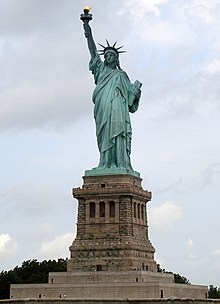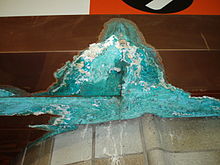Verdigris
| Verdigris | |
|---|---|
| Hex triplet | #43B3AE |
| sRGBB(r,g,b) | (67, 179, 174) |
| HSV(h,s,v) | (177°, 63%, 70%) |
| CIELChuv(L,C,h) | (67, 45, 187°) |
| Source | [1] |
| ISCC–NBS descriptor | Brilliant bluish green |
| B:Normalized to [0–255] (byte) | |

Verdigris/ˈvɜːrdɪɡriː(s)/[1]is a common name for any of a variety of somewhat poisonous[2][3][4][5]coppersaltsofacetic acid,which range in colour from green to a bluish-green depending on their chemical composition.[6]: 132 Once used as a medicine[7][8]and pharmaceutical preparation,[9]: 176 [10]verdigris occurs naturally, creating apatinaon copper,bronze,andbrass,and is the main component of a historicgreen pigmentused for artistic purposes from antiquity until the late 20th century, including ineasel painting,polychromatic sculptures,and illumination of maps.[10]: 414–423 [11]However, due to its instability, its popularity declined as other green pigments became readily available.[9]: 171 The instability of its appearance stems from itshydration levelandbasicity,which change as the pigment interacts with other materials over time.[12]: 637
History[edit]
Etymology[edit]
The nameverdigriscomes from theMiddle Englishvertegrez,from theOld Frenchverte grez.According to one view, it comes fromvert d'aigre,[13]"green [made by action] of vinegar". The modern French writing of this word isvert-de-gris( "green of grey" ), sounding like the older nameverdet gris( "grey greenish" ), itself a deformation ofverte grez.It was used as a pigment in paintings and other art objects (as green color), mostly imported from Greece, and hence it is more usually given another etymology asvert-de-Grèce( "green ofGreece").[14][15]
Production[edit]
Copper(II) acetate is prepared by treatment ofcopper(II) hydroxidewithacetic acid.[16]The historical methods used for producing verdigris have been recorded in artistic treaties,manuscriptson alchemy, works in natural history, and texts on medicine.[10]: 414 The most common ingredients used were copper and vinegar. Throughout history, recipes changed. In theMiddle Ages,copper strips were attached to a wooden block with acetic acid; the block was then buried indung.A few weeks later, the block was to be dug up, and the verdigris scraped off.[17]Another method of production was developed in 18th-centuryMontpellier,France, a locale which had the ideal climate to produce verdigris forpulverization.[9]: 177 The industry there was long dominated by women, with verdigris manufactured in household cellars using copper plates stacked in clay pots that were filled withdistilledwine.[16]The acid in the grapes caused the copper to develop crystals. The crystals ripened into verdigris and were scraped off when matured.[9]: 172 It was a profitable business, and 80% of production was sold abroad through certified female brokers. At the height of its popularity, in the 1710s, the government had to enforce inspection systems to address growing fraudulent practices. By the 20th century, the production of verdigris had moved away from Montpellier and more cost-efficient methods of producing green pigments sent the industry into decline afterWWI.[9]: 179–182
Chemical composition[edit]


Verdigris is a collective term for copper acetate, whose chemical varieties produce different hues. The technical literature is inconsistent in describing these variations. Some sources refer to "neutral verdigris" ascopper(II) acetatemonohydrate(Cu(CH3CO2)2·(H2O)) and to "blue verdigris" asCu(CH3CO2)2·CuO·(H2O)6.[18]Other sources describe the main copper salt in natural verdigris asCu4SO4(OH)6(brochantite).[19]Still other sources describe it asbasic copper carbonate(Cu2CO3(OH)2),[20]or asCu(CH3CO2)2·(Cu(OH)2)nwherenvaries from 0 to 3.[21]In marine environments, the main copper salt istribasic copper chloride(Cu2(OH)3Cl).[19][20]
Overall, variations of verdigris can be divided into two groups: basic verdigris and neutral verdigris.[6]: 132 The difference in colour depends on the hydration level and degrees ofbasicity.[12]: 637
Toxicity[edit]
Verdigris, which was once used as a medicine[7][8]and pharmaceutical preparation [9]: 176 [10]: 414 is mildly poisonous.[clarify][2][3][4][5][better source needed]Symptoms of toxicity include nausea, anemia and death, although widespread acquired immunity has been documented, as occurred with female workers inMontpellier.[22]Nontoxic substitutes have been developed for some applications, such as art pigments.
Uses[edit]

Verdigris is a naturally occurring protective layer on metals such as copper, brass, and bronze. In addition to be a desirable artistic effect, it has been used primarily as a pigment and now-outdated medicinal preparations.
Pigment[edit]
Verdigris has been used as a pigment since antiquity, including in paintings in Rome and Pompeii. The use of verdigris continued into theMiddle Ages,RenaissanceandBaroquepaintings.[6]: 132 It has been identified inThe Last Supper(1306) byGiotto.[6]: 142 During the 15th and 16th centuries, it was used in paintings for its transparency and brilliance.[12]: 637 It was difficult to create stronggreencolors in paintings due to the limitations of the existing green, yellow and blue pigments. In early Italian, Netherlandish, and German paintings, verdigris was widely used to create pure green tones forlandscapesanddrapery,such as the green coat ofSaint Johnin theMond CrucifixionbyRaphael.[23]: 46 Verdigris was used as bothglazeand opaque paint. When verdigris glaze was combined withlead whiteorlead-tin yellow,it created a deeply saturated green.[6]: 132–136 It was used in oil-based house paint for French and Dutch country houses. Verdigris also was used as an imitation of 'Chinese varnish' on Europeanlacquer.[9]: 175–176 However, during the 19th century, the use of verdigris began to decrease as alternatives such asEmerald Greenandviridianbecame more popular.[6]: 132
Stability[edit]
As a pigment, verdigris is subject to colour change. The changes are most pronounced during the first month of exposure to air. The changes also depend on the type ofbinding agentand type of verdigris used. For example, changes are less pronounced with neutral verdigris in oil andegg temperacompared to basic verdigris.[6]: 135 With aging, the green pigment in these applications will show signs of browning or darkening.[12]: 637 For example, inBotticelli'sThe Mystical Nativity,from 1500, the blue-green costumes of the angels have darkened to a dark green colour.[24]
Verdigris pigment islightfastin oil paint, as numerous examples of 15th-century paintings show. However, its lightfastness and air resistance are very low in other media. Copper resinate, made from verdigris by boiling it in aresin,is not lightfast, even in oil paint. In the presence of light and air, green copper resinate becomes stable brown copper oxide.[14]The browning mechanism is attributed to the transient formation of Cu(I) in the pigment and oil system. The reduction of Cu(II) into Cu(I) due to the release of a carboxylate, causes changes in the optical properties ofpigment.Furthermore, linseed oil induces the transformation of the copper acetate bimetallic structure, and formsmonomericseries.Dioxygenthat reacts with partiallydecarboxylateddimersto form aperoxy-Cudimer complex is responsible for the darkening of the pigment.[12]: 635–638
In previous literature on painting, verdigris has been described as unstable when combined with other pigments which leads to further deterioration. Due to the fickle nature of the pigment, it required special preparation of paint, carefully layered application, and immediate sealing withvarnishto avoid rapid discoloration (but not in the case of oil paint).[14]However, further scientific research suggests that the difficulties are less extreme than previously described. The pigment nonetheless has the ability to degrade cellulosic materials, such as paper.[6]: 137 In terms of identification and reproduction, modern technology and reproducible synthesis procedures have been developed to be used formuseumsand collections to identify distinct verdigris phases in historical artworks.[23]: 14857 Certain components of historical verdigris pigments,copper(II) acetates,are partiallyirreproduciblebased on the given historical recipes.[23]: 14847
-
One of the earliest uses of verdigris as a pigment in painting;Last Supper(1306) byGiotto Di Bondone
-
Raphaelused verdigris for the green coat ofSaint John,the left angel's frock, and other accents, inThe Mond Crucifixion
-
The Verdigris of the angels' costumes inNativita MisticabyBotticellidarkened from bluish green to foliage green.
Medicine[edit]
Verdigris has also been used in medicine,[7][8]and is identified in thePharmacologiaof John Ayrton Paris as the healing rust of the Spear ofTelephusmentioned byHomer.[7][8]Verdigris solids were also used forpharmaceutical preparations[10]: 414 in the 18th century to treatcanker sores.[9]: 176
See also[edit]
References[edit]
- ^"Its pronunciation in English is still unsettled" (Fowler's Dictionary of Modern English Usage(4 ed.) edited by: Jeremy Butterfield). The pronunciation /-ɡriːs/ is the first one given by Merriam-Webster's dictionary, but /-ɡriː/ is first in theOxford Dictionary of English(3 ed.) (2015).
- ^ab"Verdigris".Merriam-Webster Dictionary.
- ^abKarmakar, Rabindra N. (2015). Forensic medicine and toxicology: theory, oral & practical. Academic Publishers.
- ^abAnant, Jagdish Kumar, S. R. Inchulkar, and Sangeeta Bhagat (2018). "An overview of copper toxicity relevance to public health." EJPMR 5, no. 11: 236.
- ^ab"Poisoning by Verdigris".The Lancet.39(1013): 663–664. January 1843.doi:10.1016/s0140-6736(02)76992-4.ISSN0140-6736.
- ^abcdefghH. Kühn, Verdigris and Copper Resinate, in Artists' Pigments. A Handbook of Their History and Characteristics, Vol. 2: A. Roy (Ed.) Oxford University Press 1993, p. 131 – 158
- ^abcd"Medical Uses of Copper in Antiquity".Copper Development Association.Retrieved8 June2014.
- ^abcdParis, John Ayrton (1831).Pharmacologia.New York: W. E. Dean.
The rust of the spear of Telephus, mentioned in Homer as a cure for the wounds which that weapon inflicted, was probably Verdegris, and led to the discovery of its use as a surgical application
- ^abcdefghBenhamou, Reed (1984)."Verdigris and the Entrepreneuse".Technology and Culture.25(2): 171–181.doi:10.2307/3104711.ISSN0040-165X.JSTOR3104711.S2CID112614238.
- ^abcdeDe la Roja, José Manuel; San Andrés, Margarita; Cubino, Natalia Sancho; Santos-Gómez, Sonia (2007)."Variations in the colorimetric characteristics of verdigris pictorial films depending on the process used to produce the pigment and the type of binding agent used in applying it".Color Research & Application.32(5): 414.doi:10.1002/col.20311.ISSN0361-2317.
- ^Verdigris,ColourLex
- ^abcdeSantoro, Carlotta; Zarkout, Karim; Le Hô, Anne-Solenn; Mirambet, François; Gourier, Didier; Binet, Laurent; Pagès-Camagna, Sandrine; Reguer, Solenn; Mirabaud, Sigrid; Du, Yann; Griesmar, Pascal; Lubin-Germain, Nadège; Menu, Michel (2014-01-29)."New highlights on degradation process of verdigris from easel paintings".Applied Physics A.114(3): 637–645.Bibcode:2014ApPhA.114..637S.doi:10.1007/s00339-014-8253-2.ISSN0947-8396.S2CID253847558.
- ^Dauthenay, Henri (1905).Répertoire de couleurs pour aider à la détermination des couleurs des fleurs, des feuillages et des fruits.Vol. 2. Paris: Librairie horticole. p. 240. RC2.
- ^abcSt. Clair, Kassia (2016).The Secret Lives of Colour.London: John Murray. p. 215.ISBN9781473630819.OCLC936144129.
- ^The Concise Oxford Dictionary of English Etymology,edited by T. F. Hoad (1996), and Merriam-Webster's dictionary give only this second etymology.
- ^abSolomon, Sally D.; Rutkowsky, Susan A.; Mahon, Megan L.; Halpern, Erica M. (2011). "Synthesis of Copper Pigments, Malachite and Verdigris: Making Tempera Paint".Journal of Chemical Education.88(12): 1694–1697.Bibcode:2011JChEd..88.1694S.doi:10.1021/ed200096e.
- ^Darnton, Robert. "A Bourgeois Puts His World in Order" inThe Great Cat Massacre --and other Episodes in French Cultural History.New York: Vintage Books, 1985. p. 114.
- ^Richardson, H. Wayne (2000). "Copper Compounds".Ullmann's Encyclopedia of Industrial Chemistry.doi:10.1002/14356007.a07_567.ISBN3527306730.
- ^abFitzgerald, K.P.; Nairn, J.; Atrens, A. (1998). "The chemistry of copper patination".Corrosion Science.40(12): 2029–2050.Bibcode:1998Corro..40.2029F.doi:10.1016/s0010-938x(98)00093-6.ISSN0010-938X.
- ^abSharp, D. W. A:Penguin Dictionary of Chemistry,page 419. Penguin Books, 1990 (2nd edition)
- ^Kühn, Hermann (1970). "Verdigris and Copper Resinate".Studies in Conservation.15:12–36.doi:10.1179/sic.1970.15.1.002.
- ^Women and the Verdigris Industry in Montpellier,European Women and Preindustrial Craft. Project MUSE, Indiana University Press, 1995
- ^abcBette, Sebastian; Kremer, Reinhard K.; Eggert, Gerhard; Tang, Chiu C.; Dinnebier, Robert E. (2017)."On verdigris, part I: synthesis, crystal structure solution and characterisation of the 1–2–0 phase (Cu3(CH3COO)2(OH)4) ".Dalton Transactions.46(43): 14847–14858.doi:10.1039/c7dt03288a.ISSN1477-9226.PMID29043336.
- ^Bomford, David; Ashok, Roy (2009).A Closer Look at Colour.London: National Gallery, London. p. 38.ISBN978-1-85709-442-8.



